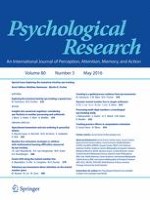15-12-2015 | Original Article
Processing multi-digit numbers: a translingual eye-tracking study
Gepubliceerd in: Psychological Research | Uitgave 3/2016
Log in om toegang te krijgenAbstract
The present study aimed at investigating the underlying cognitive processes and language specificities of three-digit number processing. More specifically, it was intended to clarify whether the single digits of three-digit numbers are processed in parallel and/or sequentially and whether processing strategies are influenced by the inversion of number words with respect to the Arabic digits [e.g., 43: dreiundvierzig (“three and forty”)] and/or by differences in reading behavior of the respective first language. Therefore, English- and German-speaking adults had to complete a three-digit number comparison task while their eye-fixation behavior was recorded. Replicating previous results, reliable hundred-decade-compatibility effects (e.g., 742_896: hundred-decade compatible because 7 < 8 and 4 < 9; 362_517: hundred-decade incompatible because 3 < 5 but 6 > 1) for English- as well as hundred-unit-compatibility effects for English- and German-speaking participants were observed, indicating parallel processing strategies. While no indices of partial sequential processing were found for the English-speaking group, about half of the German-speaking participants showed an inverse hundred-decade-compatibility effect accompanied by longer inspection time on the hundred digit indicating additional sequential processes. Thereby, the present data revealed that in transition from two- to higher multi-digit numbers, the homogeneity of underlying processing strategies varies between language groups. The regular German orthography (allowing for letter-by-letter reading) and its associated more sequential reading behavior may have promoted sequential processing strategies in multi-digit number processing. Furthermore, these results indicated that the inversion of number words alone is not sufficient to explain all observed language differences in three-digit number processing.
